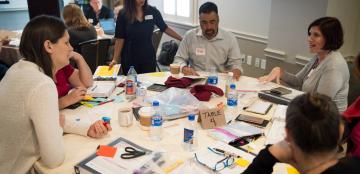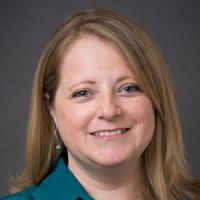
Common Solutions to Common Challenges: Opening Ourselves to Collaboration
When I was very young, most of my childhood heroes wore capes, flew through the air, or picked up buildings with one arm. They were spectacular and got a lot of attention. But as I grew, my heroes changed, so that now I can honestly say that anyone who does anything to help a child is a hero to me.
– Fred Rogers in The World According to Mister Rogers: Important Things to Remember
Working with teachers and leaders in schools around the country (and overseas), I am surrounded by heroes.
At every level of the education system, there they are: Talented and dedicated classroom teachers planning daily lessons and continually improving their practice; instructional leaders providing insight and guidance to support great teaching; school and district administrators strengthening systems to support the agency of teachers and students and to encourage powerful learning experiences.
I’ve been influenced by so many heroes who I call colleagues, mentors, and friends in the profession.
Some heroes I have worked with shoulder to shoulder, as we roll up our sleeves and solve problems together. Some heroes have shared their own successes and challenges as examples to guide my thinking as a teacher and now as a leader working with colleagues to develop and deliver high-quality services to schools.
One thing I have learned for sure from these heroes: There is power in collaboration and networking with peers.
I have been able to experience this power through the Urban Mathematics Leadership Network (UMLN) launched in 2004 and hosted by the Dana Center. Teams of mathematics leaders from large urban districts around the United States make up the UMLN membership. And since 2013, I have had the privilege of managing the UMLN work.
Over the years, UMLN has served districts that together educate more than 2 million students across the nation. UMLN leaders work in systems that face a variety of challenges—some common across all member districts, and others that are more or less unique.
UMLN convenings provide members with opportunities to learn together about new research and trends from experts in the field. Even more importantly, though, the annual retreat offers structures for leaders to learn from each other about their current work and accomplishments.
UMLN members consult with each other and Dana Center staff to make action plans and frame their work moving forward. There are also many opportunities for districts to continue to learn from each other after the convening, through relationships begun from contacts made during the meeting.
What are the benefits of participating? With our hectic schedules and deadlines and budget cuts, why make the effort to actively engage with this network?
UMLN members have reported finding new resources to explore and solutions to dilemmas that had them stuck. They note how they appreciate new perspectives shared from colleagues, from those in extremely similar situations and those in wildly different ones.
In fact, UMLN members report that sometimes the most helpful ideas come from the unlikeliest of sources! Everyone at these meetings has know-how and experience to contribute for the benefit of the group and therefore the students across the network.
At these convenings, I have seen participants find practical uses for information shared, but maybe even more importantly, develop incredible relationships with their peers. This investment in professional relationships, in making connections and learning from one other, feeds greater successes across the systems that serve our students.
I leave each convening with a greater sense of purpose. And I am fueled by inspiration and energy from colleagues focused on our shared mission of enabling our students to succeed in mathematics—and to continue on to postsecondary education.
With a focus around the 2017 UMLN convening, two member districts participated in case study interviews around their implementation of college and career readiness standards.
These case studies take a look at how the districts approached professional learning at scale around changes in instruction to help ensure student success with the mathematics they need to be prepared for their postsecondary endeavors. The case study reports give us the chance to share district leadership experience on a broader scale. Check out the reports around the work of those leaders in The School District of Philadelphia and Achievement First Public Charter Schools.
While UMLN is unique in the platform it provides for role-alike leaders from large urban districts across the nation, it is by no means the only place mathematics educators and education leaders can find collaboration or networking opportunities.
Attending conferences, actively participating in local and larger professional organizations, or joining in Twitter chats and other online collaborations can all lead to meeting peers, making personal connections, and expanding your knowledge. Look for your heroes and find your own superpowers through continual learning and growing.
About the Author
Katey Arrington
I’m from a military family, so as a child I experienced several different school systems. I’ve worked in education since I graduated college because I believe mathematics is important, accessible and beneficial for everyone if we go about teaching it well. After serving as mathematics coordinator in Pflugerville Independent School District for over 5 years, I joined the Dana Center to work on K–12 mathematics education with even more of my heroes.
Get in Touch
How can the Dana Center work with you to ensure that our nation's students are ready for postsecondary education and the contemporary workforce?

